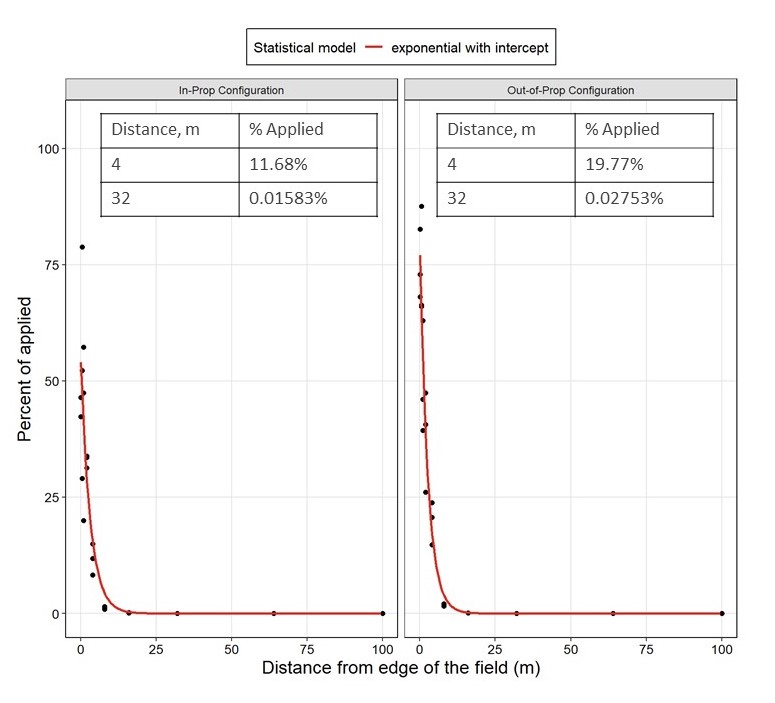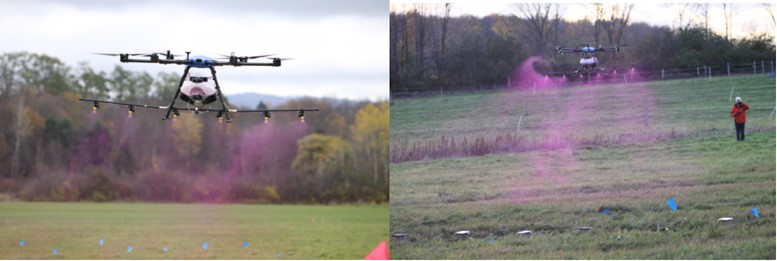UNMANNED AIRCRAFT SYSTEM (uas) Spray Drift Trial
During the first week of November 2021 Stone Environmental (Stone) teamed up with Bill Reynolds of Leading Edge Aerial Technologies (LEAT) and Professor Andrew Hewitt from the University of Queensland, to conduct a drift study using LEAT’s PrecisionVision® 35X Unmanned Aircraft System (UAS). The UAS spray drift study examined two nozzles at two application heights using two different boom configurations. Drift deposition, airborne spray flux, and droplet size data were collected using a fluorometric tracer dye, and multiple active and passive sampling media. Initial results suggest that an in-prop boom configuration produces less drift than an out-of-prop boom configuration. Keep reading below for some preliminary data from our fall study and more information on our involvement in this exciting new area of research.
Two years ago, Stone Environmental identified the emerging use of UAS for crop protection product applications as areas of research and development where our team could make a significant contribution, particularly when it comes to generating the sound science behind identifying best management practices (BMPs) and overcoming potential regulatory hurdles. Stone’s role as a leader in GLP airborne off-target movement (OTM) fieldwork and modeling uniquely positions us to help move this nascent application technology into the mainstream. As UAS use for crop protection gains increasing traction, Stone’s goal is to help develop BMPs that minimize off-target movement to reduce unwanted environmental impacts, endangered species exposure, and ensure a safe working environment for farm personnel. For the time being, Stone will continue to participate in UAS working groups, attend annual workshops, and formulate approaches based on current research and industry developments. We plan to share more detailed results from our spray drift study at an appropriate professional conference in 2022 and/or peer reviewed publication.
Fall 2021 UAS SPRAY Drift Study
The study was designed to examine off-target spray drift and deposition from several treatments made with a PV35X UAS. Treatments were comprised of various combinations of two different nozzle types with widely different droplet size spectra (coarser sprays with TTI and finer sprays with XR), two application heights (2 m and 3 m), and two different boom configurations (nozzles in-prop and nozzles out of prop). Spray drift flux and deposition data were collected using Mylar cards, monofilament, rotary impaction samplers, and Kromekote cards placed at multiple distances downwind of the UAS applications, ranging from edge of field (0 m) to 100 m downwind.
We are in the process of statistically analyzing all the data, but our preliminary results are in line with what we typically see during drift trials with conventional application methods (ground spray and manned aerial) - treatments with higher windspeed had increased deposition downwind and treatments using the TTI nozzles produced less deposition further downwind than those made with XR nozzles. Initial data from our study also appear to be confirmatory that an in-prop boom configuration produces less off-target drift deposition compared to an out-of-prop boom configuration.


In-prop boom configuration (on left) showing less turbulence versus out-of-prop boom configuration (on right) showing increased turbulence, likely contributing to greater off-target movement.
To learn more about Stone’s OTM experience or future plans for the Stone-LEAT-Professor Hewitt UAS spray drift team, contact Ben Brayden (bbrayden@stone-env.com), Director of Business Development for the Agrochemical Fate and Exposure Group at Stone.